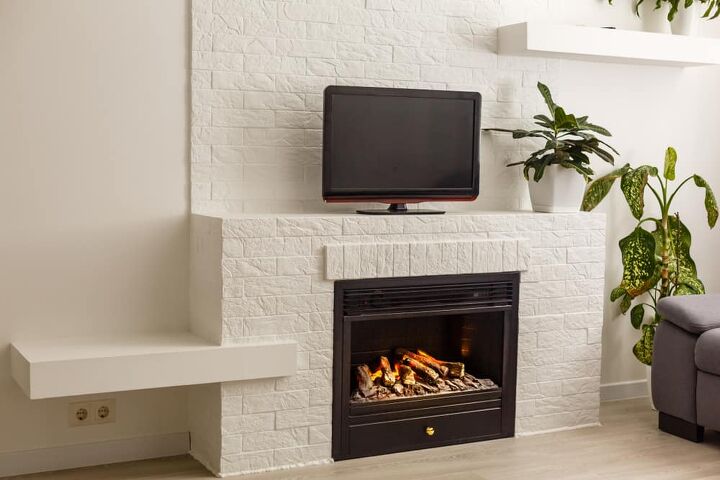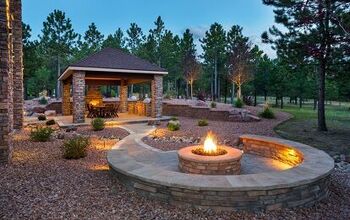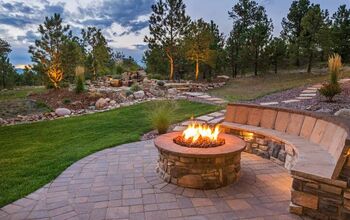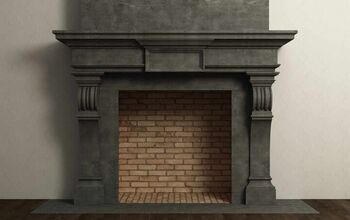How To Whitewash A Stone Fireplace (Step-by-Step Guide)

Stone fireplaces have a certain rustic look to them that makes people think about cabins in the middle of the woods. Unfortunately, sometimes, that’s not the look people want to go for. Sometimes, you want something a little more “British farmhouse” style. When that’s the case, one of the easiest ways to add a country splash is to whitewash your fireplace. But, how do you do that?
Mix equal parts white paint and water in a bucket and whisk it until it is smooth. Clean the stone façade and apply a small patch of whitewash to the stone with a brush. Paint the rest of the stone and let it dry fully so that it can last up to 30 years.
Obviously, there’s going to be a right way and a wrong way to make your fireplace get that beautiful crisp whiteness you want. If you want to get a fully whitewashed look, it’s best to get started with these directions below.
Do You Need Chimney or Fireplace Cleaning or Inspection?
Get free, zero-commitment quotes from pro contractors near you.

How Do You Make A Whitewash Mixture?
The first step to whitewashing a stone fireplace is knowing how to make a whitewash. This is actually fairly easy. All you have to do is mix white paint and water in equal portions. I suggest using a bucket for this, though you won’t need much to finish a whitewash well. Chalked paint works best for that weathered look.
Whisk your mixture together so that you can get an even, smooth consistency. Once you’ve got a whitewash mixture, it’s time to actually get your stone fireplace painted.
Do You Always Have To Mix Your Whitewash Paint?
For the most part, it’s just a good idea to mix your own whitewash. This gives you more control over the outcome of your project as well as the consistency of the paint. If you are really against the idea of mixing your paint, there is another way around it. You can always buy whitewash paint from your local hardware store.
Is Whitewashing A Fireplace A Good Idea?
Whitewashing is a great way to brighten up and modernize an otherwise retro fireplace. Assuming that you are not painting the portion of the fireplace that comes in close contact with the fire, there’s no reason to worry about the safety of whitewashing. It’s a very popular way to add extra flair to your fireplace.
Whitewashing Your Stone Fireplace: How To Do It
If you thought this was going to be a tough project, think again. This is an easy project that almost anyone can do with a little patience. Here’s how to do it:
- Start off by cleaning your fireplace the day before. You should use soapy water for this, since you want to make sure your fireplace is totally clean of any dust or residue. Rinse it off and let it dry. If your fireplace was particularly grimy, you might want to use TSP to clean it.
- Add a plastic liner at the bottom of your fireplace and protect the area with painter’s tape. If you are worried about drips around your floor or on the glass portion of your fireplace, it’s best to put some protective measures here. Painter’s tape works well for smaller areas, while placing a plastic sheet on the floor will let you avoid spilling paint on your carpeting.
- Grab your whitewash, dip a brush into it, and do a test patch. Dab away the excess onto a rag, and then apply the whitewash to a small patch to see how you like the color. To get the best results, use quick, gentle strokes. Make sure that your whitewashing reaches every nook and cranny of your stone area.
- If you like the color that your test patch gave, continue whitewashing the fireplace. It’s best to do small square sections each time. Don’t be afraid to use a rag to dab at your stonework for a little more character. If you have extremely porous stonework, like brick, don’t be afraid to use your brush and “jam it” in the holes.
- If you don’t like the color, adjust the whitewash to your liking. More paint will give you a bolder color, while adding more water will thin it out. For the most part, the 1:1 ratio seems to work with most masonry.
- Wipe up any excess whitewash that you have using a staining pad. This project goes fairly quickly, so you won’t have to wait too long to be able to wipe things up.
- Let your fireplace dry. We suggest celebrating the newly whitewashed fireplace with a cup of hot cocoa.
How Long Does Whitewash Last?
If you applied your whitewash well, you should expect it to last a minimum of 30 years. That’s how long outdoor whitewash lasts. Since you’re applying it inside, the lifespan should be far longer. This is true, even if you choose to scrub away at your fireplace once in a while.
Do You Need To Prime Your Area For Whitewashing?
Nope. If you were just painting a brick wall or painting your fireplace surround, then you probably would need to prime it and also use caulk to fill in holes. However, this isn’t a standard paint job. This is just for whitewashing, which is meant to give a somewhat uneven look.
Are There Any Alternatives To Whitewashing A Fireplace?
Yes! If you are looking for a more textured look, you might want to check out German schmears. This is a type of painting style that uses diluted mortar to paint over brick or stone. The end result is a textured, old-world look that is exceptionally European and acts as a permanent part of your fireplace.
Unlike whitewash, you can add a German schmear to the inside of your firebox without concern of it potentially damaging your fireplace interior. This is a great choice for people who want to have a more rustic yet elegant look to their homes.
Can You Whitewash The Back Of The Fireplace?
If you have a firebox you want to paint, regular paint won’t be a good match for it. Therefore, whitewashing your firebox isn’t a good idea. If you want to change the color of your firebox, then you will need to get specialized heat-resistant spray paint that is designed to be able to be used in fireplaces.
How To Paint Your Firebox
Want to complete the look? Grab some heat-resistant spray paint and follow these instructions once your whitewash is dry:
- Remove the glass plate and the fireplace plate. You will need a lot of access to your firebox in order to adequately work with your paint.
- Shut off the power to the gas, if you have a gas stove. You should never do any types of modifications to your fireplace while the gas is on. That’s just dangerous!
- Cover the fireplace equipment with newspaper. You don’t want to spraypaint your fireplace, too, do you? Use painter’s tape to tightly secure the newspaper in place.
- Shake the spray paint can to mix it up. This isn’t always necessary but it’s a good idea to do it, just in case the paint was sitting on the shelf for a while.
- Spray it on. Most people won’t spray the entire way up the flue, but if you’re a perfectionist, you can keep spraying until the fireplace no longer has any visible spots left. When you’re painting close to the hardware, it may be smarter to leave a little space or to transfer the paint to a rag that you dab on instead.
- Touch up minor details with a small paintbrush. You can spray the paint directly on the brush or just keep a smaller tray of pooled paint. Either way, it’ll work well.
- Let it dry. Once it’s totally dry, you can start the cleanup.
- Add the glass plate and fireplace plates back on, and remove the newspaper from your fireplace equipment. This would conclude your new fireplace upgrade.
Do You Need Chimney or Fireplace Cleaning or Inspection?
Get free, zero-commitment quotes from pro contractors near you.

Related Questions
What should I use to paint my fireplace surround?
If you want to paint your surround, opt for latex indoor paint designed to be heat-resistant. As long as you have those three qualities, the other details of your painting pick shouldn’t be too big an issue. Most people will choose flat, semi-gloss, or high-gloss paint for their fireplace surrounds. However, you might be able to find a more unusual finish if you keep looking around.
What type of paint should you use to make whitewash?
The best type of paint to create whitewash from is latex-based paint. If you are trying to whitewash areas near a fireplace, you also should look into a heat-resistant paint.
Do you have to seal whitewash that’s been applied to stone?
Though you might have to seal whitewash applied to furniture, there’s rarely ever any reason to apply whitewash sealant to stone. The stone’s surface should be able to take to whitewash without too much of an issue. However if you want to seal it in, by all means, do. Just make sure to choose a heat-resistant sealant if you can.

Ossiana Tepfenhart is an expert writer, focusing on interior design and general home tips. Writing is her life, and it's what she does best. Her interests include art and real estate investments.
More by Ossiana Tepfenhart




















![Cost To Drill A Well [Pricing Per Foot & Cost By State]](https://cdn-fastly.upgradedhome.com/media/2023/07/31/9074980/cost-to-drill-a-well-pricing-per-foot-cost-by-state.jpg?size=350x220)






